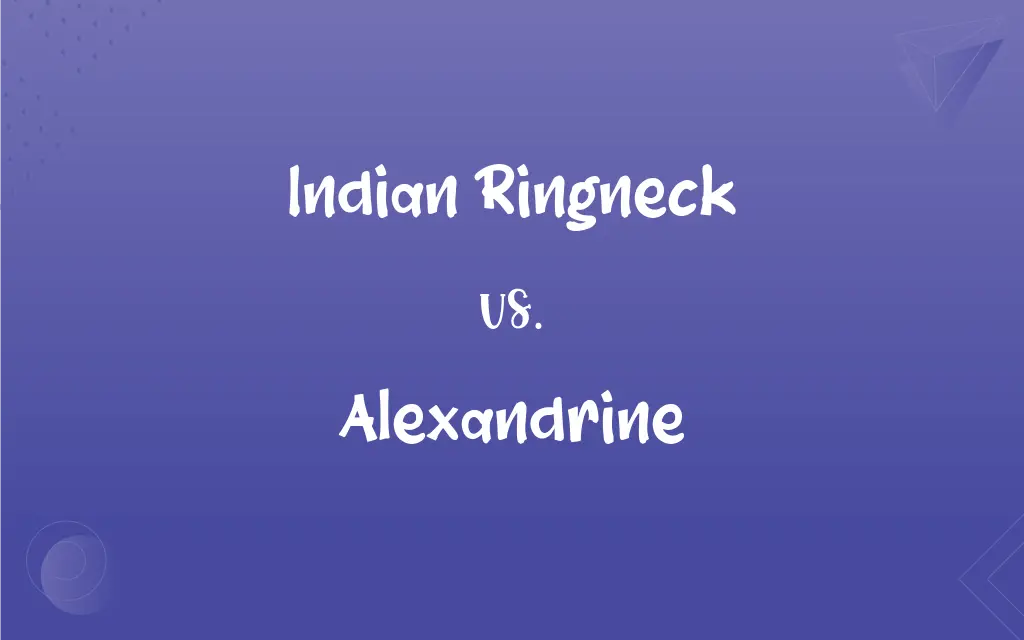Indian Ringneck vs. Alexandrine: What's the Difference?
Edited by Aimie Carlson || By Janet White || Published on February 1, 2024
Indian Ringnecks are smaller, brightly colored parrots with a distinct ring around their necks, while Alexandrines are larger, with maroon shoulder patches and a broader tail.

Key Differences
Indian Ringnecks, known for their bright green plumage and distinctive neck rings, are smaller parrots, whereas Alexandrines are noticeably larger with a more robust build and maroon patches on their shoulders.
The Indian Ringneck is celebrated for its ability to mimic human speech, showing a high level of intelligence. In contrast, the Alexandrine parrot, though also capable of mimicry, is known more for its louder, more distinct calls.
In terms of temperament, Indian Ringnecks are often energetic and playful, but can be nippy and require social interaction. Alexandrines, on the other hand, are known for being more gentle and affectionate, though they also demand social engagement.
Indian Ringnecks have a lifespan of around 20-30 years, making them a long-term commitment for pet owners. Alexandrine parrots, in comparison, can live even longer, with lifespans extending up to 40 years.
Regarding habitat, Indian Ringnecks are originally from parts of Africa and South Asia and thrive in warm climates. Alexandrines, while also native to South Asia, are more adaptable to varied climates and environments.
ADVERTISEMENT
Comparison Chart
Physical Size
Smaller, more slender build
Larger, more robust build
Distinctive Features
Bright green, neck rings
Maroon shoulder patches, broader tail
Vocal Abilities
Excellent mimicry of human speech
Loud calls, less mimicry
Temperament
Energetic, playful, can be nippy
Gentle, affectionate, social
Lifespan
20-30 years
Up to 40 years
ADVERTISEMENT
Native Habitat
Africa, South Asia
Primarily South Asia
Indian Ringneck and Alexandrine Definitions
Indian Ringneck
A small, brightly colored parrot native to Africa and South Asia.
The Indian Ringneck in the aviary was chatting away cheerfully.
Alexandrine
A larger parrot known for its maroon shoulder patches and robust build.
The Alexandrine parrot's maroon shoulders were strikingly beautiful.
Indian Ringneck
Known for its distinct ring around its neck, visible in males.
The male Indian Ringneck displayed a prominent black and pink ring.
Alexandrine
Less proficient in mimicry but known for their loud, clear calls.
The loud call of the Alexandrine echoed through the bird park.
Indian Ringneck
Requires social interaction and can be quite playful.
Our Indian Ringneck loves playing with its toys and interacting with us.
Alexandrine
Native primarily to South Asia, adaptable to various environments.
Alexandrines are often seen in different habitats across South Asia.
Indian Ringneck
A popular pet due to its intelligence and ability to mimic speech.
My Indian Ringneck can already say a few words!
Alexandrine
Tends to be gentle and affectionate, requiring social interaction.
My Alexandrine parrot loves cuddles and interacting with the family.
Indian Ringneck
Thrives in warm climates and diverse habitats.
The Indian Ringneck at the zoo adapted well to the local warm environment.
Alexandrine
Has a longer lifespan, often living up to 40 years.
Our family's Alexandrine parrot has been with us for over 30 years.
Alexandrine
A line of English verse composed in iambic hexameter, usually with a caesura after the third foot.
FAQs
What is an Indian Ringneck?
A small, intelligent parrot known for its distinctive neck ring.
Can Indian Ringnecks mimic human speech?
Yes, they are excellent at mimicking speech.
Where are Indian Ringnecks originally from?
They originate from Africa and South Asia.
What is the lifespan of an Indian Ringneck?
They typically live for 20-30 years.
Are Indian Ringnecks good pets?
Yes, with proper care and social interaction, they make great pets.
How long do Alexandrines live?
They can live up to 40 years.
Are Alexandrines good at mimicking human speech?
They can mimic, but are not as proficient as Indian Ringnecks.
Where do Alexandrine parrots come from?
They are native to South Asia.
What is the temperament of an Alexandrine parrot?
They are generally gentle and affectionate.
What is an Alexandrine parrot?
A larger parrot known for its maroon shoulder patches and loud calls.
Is the Alexandrine parrot a loud bird?
They are known for their loud, clear calls.
Do Indian Ringnecks like to play?
Yes, they are playful and enjoy interactive toys.
Are Alexandrine parrots suitable for beginners?
They can be, but their size and long lifespan require commitment.
Can Alexandrine parrots be kept with other birds?
With proper introduction and supervision, they can coexist with other birds.
Can Indian Ringnecks be trained?
Yes, with patience and consistent training.
What are the dietary needs of an Alexandrine?
A balanced diet of seeds, fruits, and vegetables.
How can you tell a male Indian Ringneck from a female?
Males have a distinct ring around their neck, which females lack.
What kind of habitat do Indian Ringnecks prefer?
They thrive in warm climates and can adapt to various environments.
Do Indian Ringnecks require a lot of attention?
They are social birds and do require regular interaction.
Are Alexandrines prone to any specific health issues?
Like all parrots, they require regular health check-ups to prevent common issues.
About Author
Written by
Janet WhiteJanet White has been an esteemed writer and blogger for Difference Wiki. Holding a Master's degree in Science and Medical Journalism from the prestigious Boston University, she has consistently demonstrated her expertise and passion for her field. When she's not immersed in her work, Janet relishes her time exercising, delving into a good book, and cherishing moments with friends and family.
Edited by
Aimie CarlsonAimie Carlson, holding a master's degree in English literature, is a fervent English language enthusiast. She lends her writing talents to Difference Wiki, a prominent website that specializes in comparisons, offering readers insightful analyses that both captivate and inform.































































